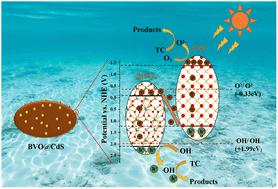当前位置:
X-MOL 学术
›
Dalton Trans.
›
论文详情
Our official English website, www.x-mol.net, welcomes your feedback! (Note: you will need to create a separate account there.)
CdS QDs grown on ellipsoidal BiVO4 for efficient photocatalytic degradation of tetracycline
Dalton Transactions ( IF 4 ) Pub Date : 2024-04-16 , DOI: 10.1039/d4dt00586d Kai Liu 1 , Mao-Jin Ran 1, 2 , Zhi-Rong Li 1, 2 , Yi-Fu Huang 1 , Ze-Yu Jiang 1 , Wan-Ying Li 1 , Shokir Khojiev 1, 3 , Zhi-Yi Hu 1, 2 , Li-Hua Chen 1 , Jing Liu 1 , Yu Li 1 , Bao-Lian Su 1, 4
Dalton Transactions ( IF 4 ) Pub Date : 2024-04-16 , DOI: 10.1039/d4dt00586d Kai Liu 1 , Mao-Jin Ran 1, 2 , Zhi-Rong Li 1, 2 , Yi-Fu Huang 1 , Ze-Yu Jiang 1 , Wan-Ying Li 1 , Shokir Khojiev 1, 3 , Zhi-Yi Hu 1, 2 , Li-Hua Chen 1 , Jing Liu 1 , Yu Li 1 , Bao-Lian Su 1, 4
Affiliation

|
Designing efficient, inexpensive, and stable photocatalysts to degrade organic pollutants and antibiotics has become an effective way for environmental remediation. In this work, we successfully performed in situ growth of CdS QDs on the surface of elliptical BiVO4 to try to show the advantage of the binary heterojuncted photocatalyst (BVO@CdS) for the photocatalytic degradation of tetracycline (TC). The In situ growth of CdS QDs can provide a large number of reactive sites and also generate a larger contact area with BiVO4. In addition, compared with mechanical composite materials, in situ growth can significantly reduce the energy barrier at the interface between BiVO4 and CdS, providing more channels for the separation and migration of photogenerated charge carriers, and further improving reaction activity. As a result, BVO@CdS-0.05 shows the best degradation efficiency, with a degradation rate of 88% after 30 min under visible light. The TC photodegradation follows a pseudo-second-order reaction with a dynamic constant of 0.472 min−1, which is 6.47 times that of pure BiVO4, 7.24 times that of pure CdS QDs and 2 times that of the mechanical composite. The degradation rate of BVO@CdS-0.05 decreases to 77.8% with a retention rate of 88.5% after four cycles, demonstrating excellent stability. Through liquid chromatography-mass spectrometry (LC-MS) analysis, two possible pathways for TC degradation are proposed. Through free radical capture experiments, electron spin resonance measurements, and photoelectrochemical comprehensive analysis, it is confirmed that BVO@CdS composites have constructed an efficient Z-scheme heterojunction via in situ growth, thereby highly enhancing the separation and transport efficiency of charge carriers.
中文翻译:

在椭圆形 BiVO4 上生长的 CdS QD 可有效光催化降解四环素
设计高效、廉价、稳定的光催化剂来降解有机污染物和抗生素已成为环境修复的有效途径。在这项工作中,我们成功地在椭圆形BiVO 4表面原位生长CdS QD ,试图展示二元异质结光催化剂(BVO@CdS)在光催化降解四环素(TC)方面的优势。 CdS QD的原位生长可以提供大量的反应位点,并且还可以与BiVO 4产生更大的接触面积。此外,与机械复合材料相比,原位生长可以显着降低BiVO 4和CdS界面的能垒,为光生载流子的分离和迁移提供更多通道,进一步提高反应活性。结果表明,BVO@CdS-0.05表现出最好的降解效率,在可见光下30 min后降解率为88%。 TC光降解遵循准二级反应,动态常数为0.472 min -1,是纯BiVO 4的6.47倍,纯CdS QD的7.24倍,机械复合材料的2倍。经过四个循环后,BVO@CdS-0.05的降解率降至77.8%,保留率为88.5%,表现出优异的稳定性。通过液相色谱-质谱 (LC-MS) 分析,提出了两种可能的 TC 降解途径。通过自由基捕获实验、电子自旋共振测量和光电化学综合分析,证实BVO@CdS复合材料通过原位生长构建了高效的Z型异质结,从而大大提高了载流子的分离和传输效率。
更新日期:2024-04-16
中文翻译:

在椭圆形 BiVO4 上生长的 CdS QD 可有效光催化降解四环素
设计高效、廉价、稳定的光催化剂来降解有机污染物和抗生素已成为环境修复的有效途径。在这项工作中,我们成功地在椭圆形BiVO 4表面原位生长CdS QD ,试图展示二元异质结光催化剂(BVO@CdS)在光催化降解四环素(TC)方面的优势。 CdS QD的原位生长可以提供大量的反应位点,并且还可以与BiVO 4产生更大的接触面积。此外,与机械复合材料相比,原位生长可以显着降低BiVO 4和CdS界面的能垒,为光生载流子的分离和迁移提供更多通道,进一步提高反应活性。结果表明,BVO@CdS-0.05表现出最好的降解效率,在可见光下30 min后降解率为88%。 TC光降解遵循准二级反应,动态常数为0.472 min -1,是纯BiVO 4的6.47倍,纯CdS QD的7.24倍,机械复合材料的2倍。经过四个循环后,BVO@CdS-0.05的降解率降至77.8%,保留率为88.5%,表现出优异的稳定性。通过液相色谱-质谱 (LC-MS) 分析,提出了两种可能的 TC 降解途径。通过自由基捕获实验、电子自旋共振测量和光电化学综合分析,证实BVO@CdS复合材料通过原位生长构建了高效的Z型异质结,从而大大提高了载流子的分离和传输效率。



























 京公网安备 11010802027423号
京公网安备 11010802027423号